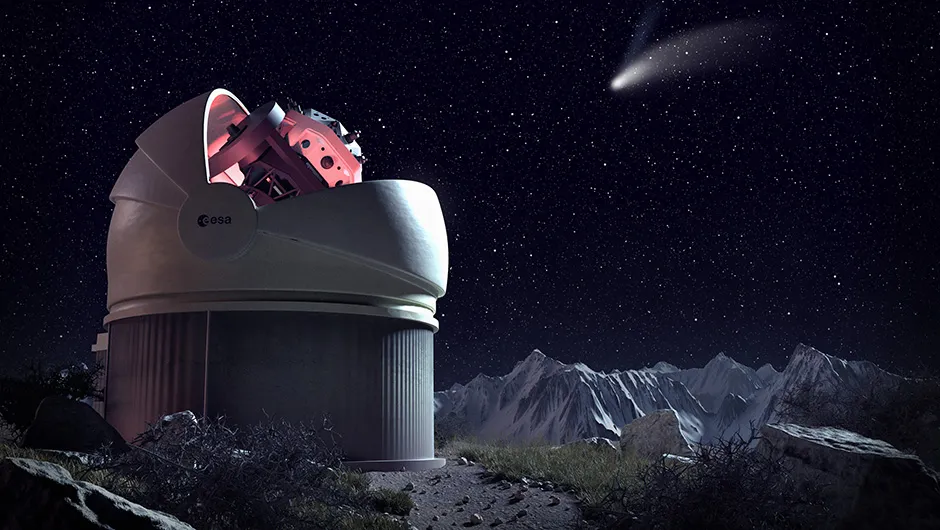The world is being bombarded from space.
Every day, hundreds of tonnes of space rock and dust hit our planet’s atmosphere – most of which fortunately burns up in the atmosphere.
But that’s not always the case.
On 30 June 1908, an asteroid came down near the Tunguska River in Siberia, flattening 2,000 square km of woodland.
If a similar event were to happen today over a major city, the casualty count would be in the millions.
In 1908, no one could have seen the meteor coming, but with today’s technology we have no such excuse.
On the anniversary of the Tunguska event, scientists gather together for Asteroid Day, sending out a rallying cry to watch for these potentially fatal space rocks.
Already there are several NASA-run surveys scanning for potential impactors.
They scan up to 6,000 square degrees of sky per night, looking for near-Earth objects (NEOs) – the space rocks with orbits that will bring them close to our planet and could potentially hit us.
“These surveys discover asteroids by taking a series of three or four images of the same area of sky over an hour,” says Paul Chodas, manager of the JPL centre for NEO studies.
“Then a computer program searches for pinpoints of light that are moving across the star background in that time.”
Word is then sent around a network of amateur and professional astronomers who will train their telescopes on the object to try and learn as much as they can about its path before it disappears from view.
“If a survey telescope discovers an asteroid, its position is only very poorly known,” says Detlef Koschny, co-manager of ESA’s NEO segment.
“Someone has to perform observations over the next few days so that we get a longer orbital arc.”
Once these observations are complete, forecasts can be made of the asteroid’s orbit up to 100 years into the future, allowing us to determine whether a rock threatens Earth.

But we need to do better
Despite all these surveys, NEOs are still slipping through – the most famous of recent memory being the 20m Chelyabinsk meteor of 15 February 2013.
The resulting shockwave broke windows and shook buildings, injuring 1,500 people.
And it had come as a complete surprise.
“Of the NEOs between 20m and 40m we know less than one per cent,” says Koschny.
“There’s a lot left out there in that size range.
That’s why we need to scan the whole sky every night, only then will we detect the small objects.”
To accomplish this task, ESA has begun constructing a new type of survey scope, currently named the ‘fly-eye telescope’.
It will have a massive 45 square degree field of view and will be devoted to ensuring that small, dim NEOs don’t slip through the net. It is due to start operating in 2018.
Asteroid detection rates are also improving thanks to NASA’s WISE satellite.
As well as being able to image at any time – regardless of whether it is a clear night on Earth – being beyond our planet’s atmosphere allows researchers to search in the infrared.
And, as Chodas points out, “Asteroids are brighter than the background stars in the infrared, so they stand out better.”
WISE has been searching the sky for NEOs in the infrared since 2013.

As of April 2016 it had discovered 72 new objects, and was observing hundreds more.
With new surveys and improved technology, the rate of detection has been rising steadily.
Should an asteroid pose a serious threat to us, it is increasingly likely that we would detect it and assess its danger long in advance.
The question then is: what would we do next?
For smaller asteroids, just knowing that they are coming would be enough to avoid most harm.
These rocks mostly break up in the atmosphere and any damage from the resulting shockwave can be easily avoided.
“All you would need to do is contact the media and tell people not to stand near windows in case they shatter,” says Koschny.
“For objects larger than 100m, though, you would want to evacuate.”
Finalising evacuation plans could be problematic, however.
It is possible to estimate where an asteroid might land, but only within hundreds of kilometres.
Even if you could get every person to safety, an impact in an urban area would have severe (and potentially long-lasting) ramifications to housing, utilities, infrastructure and so on.
Instead, it would be better to avoid the impact altogether.
Given a decade’s notice, deflecting an asteroid is relatively straightforward in theory.
If an asteroid’s velocity can be slowed so that it crosses Earth’s orbit a few hours later, a collision could be avoided.
Plans are already in place to test the theory by firing a projectile into an asteroid, altering its speed.
This is the Asteroid Intercept and Deflection Assessment (AIDA) mission, a joint NASA/ESA venture.
But the only way such a deflection plan could work on a potentially devastating asteroid is with enough advance warning.
So in order to avoid disaster, it is vital we keep searching the skies.
This article was originally published in the July 2016 issue of BBC Sky at Night Magazine.
